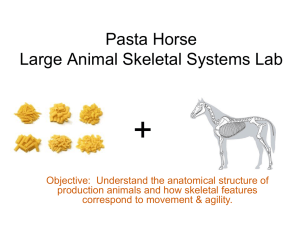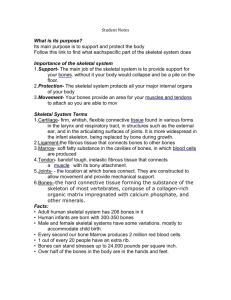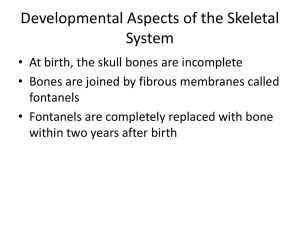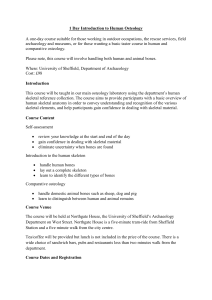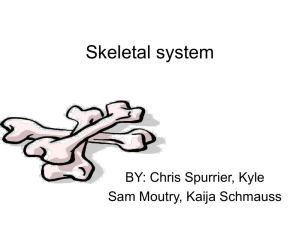Final UBD Lesson Plans_Kasey
advertisement
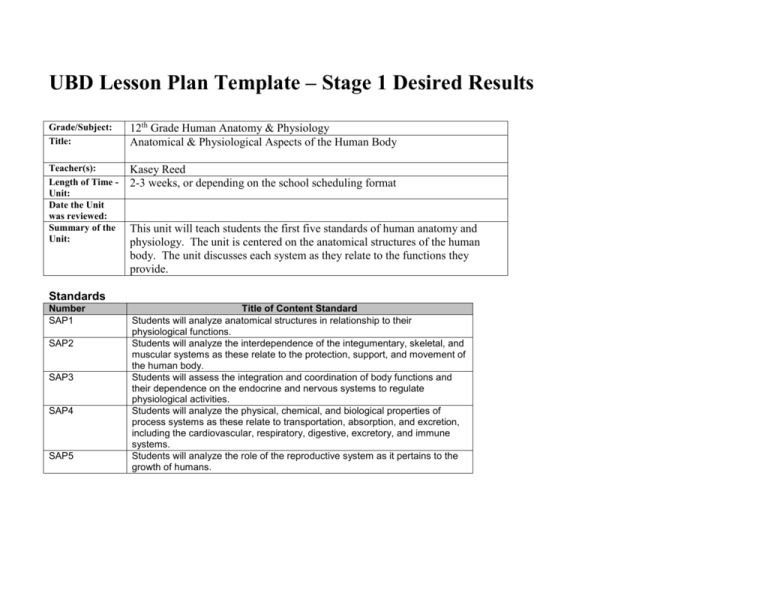
UBD Lesson Plan Template – Stage 1 Desired Results Grade/Subject: Title: 12th Grade Human Anatomy & Physiology Anatomical & Physiological Aspects of the Human Body Teacher(s): Length of Time Unit: Date the Unit was reviewed: Summary of the Unit: Kasey Reed 2-3 weeks, or depending on the school scheduling format This unit will teach students the first five standards of human anatomy and physiology. The unit is centered on the anatomical structures of the human body. The unit discusses each system as they relate to the functions they provide. Standards Number SAP1 SAP2 SAP3 SAP4 SAP5 Title of Content Standard Students will analyze anatomical structures in relationship to their physiological functions. Students will analyze the interdependence of the integumentary, skeletal, and muscular systems as these relate to the protection, support, and movement of the human body. Students will assess the integration and coordination of body functions and their dependence on the endocrine and nervous systems to regulate physiological activities. Students will analyze the physical, chemical, and biological properties of process systems as these relate to transportation, absorption, and excretion, including the cardiovascular, respiratory, digestive, excretory, and immune systems. Students will analyze the role of the reproductive system as it pertains to the growth of humans. Understandings: Essential Questions: Students will understand or know how to…… [Learning outcomes] Unit concepts that reside at the heart of the subject. Ex. What was the position of the characters in this story? What do the terms anatomy and physiology mean and how are they related? What are the major characteristics of life? What are the different levels of organization of the human body? What are the major organ systems and what are the organs associated with each? How is chemistry important in living things? How do molecules make our bodies move and function in everyday life? How do cells differ from one another? What tissues make up the human body? What are the layers of the skin? How are bones classified according to their shapes and what are examples of each group? How do muscles contract? What are the general functions of the nervous system? How are hormones important to the endocrine system? What are the organs in the cardiovascular and lymphatic systems? How does the digestive system break down food? What are the functions of the organs in the urinary system? What are the functions of both the male and female reproductive systems? Students will understand that… certain physiological functions depend on anatomical structure each bodily system functions together to make one organism (the human body) bodily systems carry out and maintain certain functions the integumentary, skeletal, and muscular systems relate to the protection, support, and movement of the human body the endocrine and nervous systems regulate physiological activities the cardiovascular, respiratory, digestive, and excretory systems relate to transportation, absorption, and excretion of human properties the reproductive system pertains to the growth and development of human How does the body work together to carry out the important functions in life? How do living things function? Knowledge: Skills: Students will need to know: Students will need to do: Students will need to know… 1. The structure of the integumentary system to its functional role in protecting the body and maintaining homeostasis. 2. The interactions among hormones, senses, and nerves which make possible the coordination of the functions of the body. 3. The effects of aging on body systems. 4. The conditions that change normal body functions and how the body responds. Students will need to: 1. Apply correct terminology when explaining the orientation of body parts and regions. 2. Explain the role of homeostasis and its mechanisms as these relate to the body as a whole. 3. Describe how structure and function are related in terms of cell and tissue types. 4. Explain how the skeletal structures provide support and protection for tissues, and function together with the muscular system to make movements possible. 5. Describe how the body perceives internal and external stimuli and responds to maintain a stable internal environment. 6. Describe the chemical and physical mechanisms or digestion, transportation, and absorption within the body to change food to energy. 7. Analyze and explain the relationships between the respiratory and cardiovascular systems. 8. Explain how functions of the reproductive organs are regulated. 9. Describe the stages of embryology. 10. Describe the stages of development from birth to adulthood. UBD Lesson Plan – Stage 2 - Evidence of Learning Performance Task Title of Content Standard: GOAL To examine and teach the skeletal system of the human body. ROLE Each student will become archeologists who are in search for skeletal remains of a human body that was lost long ago in Africa. One part of the class will search for bones in the appendicular skeletal system while the other part of the class searches for the bones located in the axial skeletal system. The class will then combine to put these parts of the skeletal system into one complete skeleton. AUDIENCE 12th grade Human Anatomy students SITUATION Students, through imagination and creativity, will leave their normal classroom and explore certain areas of Africa. Each student will take on the role of investigators and archeologists. A body has been missing for nearly 80 years in the Sahara desert and it is up to the students to find the complete remains of their skeletal system. Once they have found the complete skeletal system they must put the skeleton together as an entire system. PRODUCT, PERFORMANCE AND PURPOSE This particular project will be completed over a one-week span. The class will be divided into two different groups. There will be six members in each group. Four members of the group are the actual archeologists searching for lost bones; the other two members will serve as reporters, giving a detailed, play-by-play report of each bone found, using their imagination to be creative to come up with where each bone was found and how the group went about retrieving it. Group A will be archeologists searching for the axial skeleton components while Group B will search for the appendicular skeleton components. The students will use a webquest, a web based inquiry, to search for different parts of the skeletal system. Once the students have found the entire list of bones for their particular part of the skeletal system, they will cut them out or draw them, etc. It is the group’s job to be creative. The students have until Friday to complete their individual assignments. Once both groups have completed this part of the task, they will come together to compile the completed life size skeleton. On this Friday, the students will come in dressed as they are archeologists (hat, vest, boots, etc) or news reporters. They will put together the long lost skeletal remains. They will use our bulletin board as the “investigation table”, to display their wonderful finds. Once the students have a completed skeletal system their mission will be complete. Their skeleton must be formed together, with each bone in the appropriate place. STANDARDS AND CRITERIA SAP2- Students will analyze the skeletal system as it relates to the protection, support, and movement of the human body. The students are learning the entire unit of the skeletal system. Students are learning to work together as a group by using creativity, logic, and grouping skills. Students will be able to recognize bones and be able to place them where they need to be in the skeletal system. Other Evidence (e.g., tests, quizzes, prompts, work samples, observations) Worksheet A- Completing the Axial Skeletal System Worksheet B- Completing the Appendicular Skeletal System Test- Over the complete skeletal system; labeling the entire skeleton Self-Assessment Student Self-Assessment and Reflection Students will grade each other on how well they worked in a group. At the end of the assignment they will write me a reflection paper on their experience. They will give me feedback, either positive or negative, on how they felt about the project. Rubric for Performance-Based Assessment RUBRIC FOR THE PERFORMANCE TASK List Criterion Overall Knowledge of Skeletal System Creativity (For Friday’s Dress Particiaption) Technology Beginning 0-3 points Not all bones were located and they were not placed in the correct position on the completed skeleton. The student did not partake in the dress-up activity at all. There was no costume or dress up. Developing 4-6 points Only 90% of the bones were located and not all of the bones were placed in the correct position on the skeleton. Accomplished 7-8 points All of the bones were located and placed in the correct position on the skeleton model. The student wore a partial outfit, with several pieces of the outfit missingalmost as if they just threw something together in the morning. The student was well prepared. The student met the requirement of dressing up. The student looked the part of the character they portrayed. The students The students The students Exemplary 9-10 points All of the bones were located and placed neatly in the correct position on the skeleton; the completed skeleton is very organized The student went well beyond the expectations of this activity. They completely dressed the part of the character they portrayed, acting the part as well. The students Score Use were absolutely clueless on how to use the web and technology to complete their project had limited knowledge on how to use the web and technology to complete the project. used the web and technology effectively when creating their project. Group Work The student did not work together with his/her group at all. The student caused problems and could not work well with others. The student was part of the group but relied mainly on his/her teammates to pick up the responsibility of their work. The student worked well with others, doing the things required without being asked. went well beyond their technology use. They not only used the web and technology to create their project, but they used even the smallest applications to make an outstanding project. The student kept his/her group together. They were the team leader and pulled everything and everyone together. The student listened to suggestion and work cooperatively with all group members. UBD Lesson Plan- Stage 3-WHERETO Learning Plan (Stage 3) Where, Why, & What Goals: Students will gain knowledge of the skeletal system. Students will be able to explain the functions of the skeletal system. Students will analyze the skeletal system as it relates to protection, support, and movement of the human body. Students will be able to understand essential questions and ideas within the unit: 1) How are bones classified according to their shapes and what are examples of each? 2) How is the skeletal system broken down? 3) What are the bones of the axial skeletal system and appendicular skeletal system? 4) What are the bones of the skull? 5) How are the three sections of bones in the hands and feet broken down? 6) How is the skeletal system important in our human body? 7) What are the main functions of our skeletal systems? 8) How does the skeletal system enable us to function? Students will be given a schedule of the requirements of the unit. (See Calendar) Expectations: To understand these goals, students will read the chapter, participate in group activities, and listen to oral lecture for content; complete a webquest for the technology of the class, and ultimately, and the students will use a graphic organizer to engage their minds in the content area. Relevance and Value: To use information accurately and creatively: The students use oral instruction, chapter readings, graphic organizers, interactive lessons and research from electronic sources and webquests to compile a complete knowledge of the skeletal system. Diagnosis: Prerequisite skills Knowledge of other body systems Prior instruction of basic skeletal system terms A somewhat understanding of the skeletal system and how the body functions Be able to understand the chapter and successfully completed the end of chapter review Evaluate what students know about the compiling a skeletal system from a variety of missing bones. (Logical Entry Point) Evaluate what students know about information found on the internet to see if they can follow instruction and complete a project within a group. ((Aesthetic & Narrative Entry Points) Evaluate their current knowledge of the content material by class discussions the interactive boards. (Foundational & Experiential Entry Points) Hook & Hold Begin by asking “What makes our body’s move and function?” We will discuss the main parts of the skeletal system orally and see visual aspects of the system. We will start with the basic elements of the skeletal system. The students will start with two graphic organizers. The students will be given copies of the graphic organizer that they must complete on their own. The first graphic organizer will be for a lower order of learning with the second organizer being for a higher order of learning. The students will complete these at their desk and then they will come to the interactive board and complete the organizer. This will allow the students to touch and move the objects that are needed to move. (Aesthetic, Narrative, Logical, & Experiential Entry Points) -The first graphic organizer will be that of a lower order of learning. This is a very simple organizer based on the skeletal system. The students should be able to identify which objects relate to the skeletal system. There are several different images located on the page; some objects relate to the skeletal system and others do not. The students should be able to decide correctly which images belong to the correct category. (Aesthetic, Narrative, Logical, & Foundational Entry Points) -The next graphic organizer will be that of a higher order of learning. This is a more complex organizer based on the skeletal system. Here the students will be required to know the structure and descriptions of four of the major bones in the skull. The bones that students will have to describe include the parietal bone, temporal bone, occipital bone, and frontal bone. (Aesthetic, Narrative, Logical, & Foundational Entry Points) - After students complete these graphic organizers on their own, we will use the interactive board to allow students to come up and complete the assignment. This allows all students to be engaged in the activity. -Interactive Lessons include: labeling, dragging items to the correct location, and matching. (All Entry Points) - Then have the students label an entire skeleton with all of the main bones. (Aesthetic, Logical, Foundational, & Experiential Entry Points) Explore & Equip Read the chapter discussing the skeletal system. (Narrative Entry Point) Students should take individual notes on the chapter. (Narrative Entry Point) Lecture and discussion through a visual learning opportunity (Narrative & Aesthetic Entry Points) Students will use graphic organizers to engage their minds about the content of the system. (Aesthetic, Narrative, Logical, & Foundational Entry Points) Interactive/smartboard activities including labeling, stating, and hands on touching (Aesthetic, Narrative, Logical, Foundational, and Experiential Entry Points) Students will use the interactive boards to re-create the graphic organizers. (Aesthetic, Logical, Foundational, Experiential Entry Points) Practice labeling skelteons as a class (Logical & Foundational Entry Points) Introduce learning content in Graphic Organizers, PowerPoint presentation/Interactive board presentation for the foundations and principles of the skeletal system(Aesthetic & Narrative Entry Points) Components: Break down parts of the skeletal system: Axial & Appendicular Discuss functions of the skeletal system as a whole Labeling bones View Video “How Bones Move: Bone Song” (Aesthetic Entry Point) Introduce worksheet to help with labeling and knowledge of the bones. Students can also view the websites and webquests on the topic of Anatomy/Skeletal System. (Aesthetic, Narrative, Experiential Entry Point) http://teacherweb.com/WQ/HighSchool/SkeletalSystem http://www.mnsu.edu/emuseum/biology/humananatomy/skeletal/skeletalsystem.html http://anatowiki.wetpaint.com/page/Axial+skeleton?t=anon http://www.bio.psu.edu/people/faculty/strauss/anatomy/skel/skeletal.htm Rethinking , Reflection, & Revision Students will use two different graphic organizers to get a grasp on certain aspects of this chapter. Students will examine other articles or journals for content. They will create a summary over what they have found. Students will write daily in their anatomy journal based on journal topic for that day. Students will fill out worksheets to review the different bones of the skeletal system. Students will research information about one disease that affects the skeletal system and present it to the class in some way. Daily, students will come up to the class skeleton and practice reviewing each bone and the function it provides. In groups of 6, students will complete a webquest. Students who finish early can do an additional enrichment activity. Evaluation & Self-Evaluation Students will reflect daily on how well they think they are learning. They will tell me at least two things that they have learned during the day. (Student Evaluation) After completing the review worksheets, students will grade each other’s work. Students will grade their own graphic organizers by going back through the book, correcting any mistakes. Students will complete a webquest over the bones in the skeletal system. (Teacher Evaluation) In journals and in class discussion students evaluate the questions: What are the major parts of the skeletal system? How is the skeletal system important for everyday function? How does the skeletal system allow the body to move? What were your strengths when learning about the skeletal system (what was the easiest part to learn)? What were your weaknesses when learning about the skeletal system (what was the most difficult part to learn)? Tailor to student needs Slow readers: Verbally explain the steps in completing the graphic organizers. Given extended time on assignments and shortened reading assignments. Receive oral instructions and pair them up with a peer that can help them. Work with them more one on one when looking at the skeletal system. Scavenger hunt activity/completing a skeleton can be done in groups. When working on things that need to be read, such as the webquest, break the class into groups. Hearing impaired: Receive teacher notes and written instructions of all assignments and discussion items. Make sure I use visual cues as to what I am wanting. Make sure I face the class when communicating, so that the students can read my lips. Attention deficit disorder: Have their assignments broken down into smaller assignments. Have a reward system, rewarding them if they stay on task, completing their work on time. Try to keep them on task. Decrease the amount of distraction. Have the child’s desk closer to mine. Slow Learners: These students will have extra time to complete the assignment. Some assignments will be modified to these students depending on their ability. Most of these learners will work with the special education co-teachers as a group. Advanced Learners: These students will be given extra work for when they finish other assignments. These learners will have “challenge worksheets” to complete. These worksheets are more difficult than normal worksheets. Also, once a week, these students will research a topic of their choice and write a paper discussing their findings. Organize learning See course planning calendar. We will begin the unit by reading the chapter on the skeletal system. Students will take notes as they read. Students will complete a WebQuest based on the skeletal system. Students will complete graphic organizers to introduce the content of the chapter. We will discuss this chapter by means of an interactive lesson using the graphic organizers. The interactive lesson will have informative information based on content and it will also consist of interactive activities that will engage, hook, and hold the students. Labeling worksheets will be given to each student to keep the student in practice of labeling the bones of the human skeleton. Quizzes will be given, just like the labeling worksheets, to review the skeletal system and keep those thoughts coming back for easy recognition. The chapter test will encompass everything that the students have learned during the course of the unit. This test will be one form of assessment. Unit Plan Schedule for November 2008 Mon s Tue Wed Thu Fri 3 Start Unit Plan 4 Read/Discuss Chapter 5 Read/Discuss Chapter 10 Graphic Organizer 1 Interactive Lesson 11 Graphic Organizer 1 Due Interactive Lesson 12 Correct Graphic Organizer 1 Interactive Lesson 13 WebQuest Due Graphic Organizer 2 14 Labeling Worksheets Graphic Organizer 2 Due 17 Interactive Lesson Plan 18 Interactive Lesson Plan with Graphic Organizers 19 Interactive Lesson Plan with Graphic Organizers 20 Labeling Practice 21 Labeling QUIZ Assign WebQuest 6 Interactive WebQuest Time 7 Interactive Correct Graphic Organizer 2 24 Label on Skeleton HW: Worksheet 31 HW: Worksheet HW Due 25 Label on Skeleton HW Due 26 Review Bones Lesson Lesson 27 Chapter/Unit Review 28 Unit/Chapter TEST
